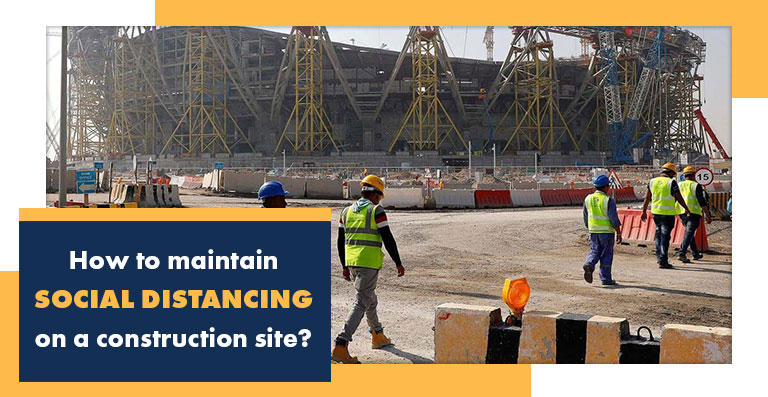How to maintain Social Distancing on a construction site?

COVID-19 as changed the way the world functioned. The pandemic in the early part of the year brought the world to a standstill but it soon became apparent that COVID-19 was here to stay, and the only way to gain some semblance of normalcy was to create a ‘new normal’.
As the construction industry slowly restarts after a brief hiatus it does so with health and safety protocols. For an industry primarily consisting of labourers who work in close proximity to one another not by choice but by necessity; implementing social distancing procedures here is a mammoth task. However, to ensure the safety of the workers they are left with the only option – of being creative and finding different ways to enforce social distancing measures on the construction site.
Below we provide three ways in which construction companies can utilize the benefits of modern construction technology to maintain social distancing on site.
1. Social Distancing amongst construction workers:
The employer or the project manager must find ways which would increase distance between employees. This can be done by modifying work schedules and increasing the total working hours but dividing the workforce into two different shifts. This would ensure the productivity remains high but there will be less number of people working on site at a given time. Areas which are confined or enclosed should be identified like trailers, small rooms etc. and its entry should be restricted to only the essential personnel. The indoor areas which are used by everyone like lunch rooms should be constantly sanitized and also should have a limit on maximum number of people who can occupy at the same time.
A lot of companies are now choosing to invest in machinery which would help workers. For instance, in order to lift a concrete slab three or four workers might need to work in close proximity. A machine here can be used instead to lift the heavy load and reduce the number of people working together.
Finally, wearing PPE or even a mask might be difficult when it comes to workers doing the manual labour tasks. But areas should be identified where PPE kits can be worn especially supervisors who are going to multiple teams and sites. They can be super-spreaders and they should be extremely cautious so that even if there is an outbreak then it can be contained to a single operating team.
2. Video Monitoring:
Today, one can easily obtain camera systems with features that provide highly detailed images or videos of the job site. These can be Cat5 cable, thermal sensors, motion alerts, night visions etc. Mounted upon a drone they can be used to convey what is happening on the job site in real time. It nullifies the need of physical human presence. Also by video monitoring manager, supervisors and safety managers can from a distance keep track of the work not in one singular location but at different areas simultaneously. They can here notice if a lot of people are crowding at a same location and advise them to disperse or solve the same problem in a way that requires less number of people.
3. Effective Planning:
Now more than ever there is a need to manage time and schedule in a manner that there is no scheduling overlap on the construction project which would by default translate into more people. BIM Services allows to do so by adding the fourth dimension of time. Project management tools like Primavera can be integrated with BIM tools like Revit to optimize the entire supply chain and logistics. It also allows to track the resources and communicates the progress of activity to the site engineers and consultants. This means that there is no need for manual checking of the materials. By proper scheduling two construction processes that require the same instrument can also be scheduled with proper time gaps so the instruments can be properly sanitized in the middle.
4. Remote Collaboration:
A lot of meetings, presentations, decision making etc. which were done in boardrooms can now with Building Information Model be done virtually without any physical meeting necessary. It is important that the project data must flow seamlessly between all the disciplines to ensure that the model created is accurate and precise. BIM is digital replica of the actual building to be constructed and from it 2D drawings are extracted to be used for onsite constructions. By clash detection in the virtual desing BIM can guarantee error free drawings so that components and elements will go precisely where they are supposed to at the right time. There is thus no need to make unnecessary changes to cover up any mistakes. For instance: There is a hard clash between MEP BIM Services(duct) and Structural BIM (beam). If this clash was not detected during the pre-designing phase, but during the actual construction then it would lead to significant damages and alterations in the design all of which require human input. Here the teams from different departments might need to physically meet to problem solve, new materials may also be needed, something might need to be broken down etc. Since, with BIM clash is detected before actual construction in the virtual 3D model the consequent human interactions are not required.
Conclusion:
Construction companies are conscious of the significant impact of social distancing but it is neither possible for them to operate in a vacuum nor is it possible to stop the construction process altogether. The only viable solution is creating better procedures and implementing new methods that would make the very best of a difficult situation.

